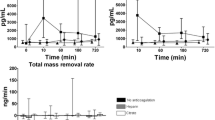Abstract
Objectives: To determine whether continuous venovenous hemofiltration leads to extraction of tumor necrosis factor alpha (TNFα) and cytokines from the circulation of critically ill patients with sepsis and acute renal failure and to quantitate the clearance and the removal rate of these cytokines and their effect on serum cytokine concentrations. Design: Prospective, controlled study in patients with continuous venovenous hemofiltration (24 l/24 h) using a polysulphone membrane in patients with acute renal failure. Patients: 33 ventilated patients with acute renal failure of septic (n = 18) and cardiovascular origin (n = 15) were studied. Interventions: Hemodynamic monitoring and collection of blood and ultrafiltrate samples before and during the first 72 h of continuous hemofiltration. Measurements and main results: Cardiovascular hemodynamics (Swan-Ganz catheter), Acute Physiology and Chronic Health Evaluation II score, creatinine, electrolytes, and blood urea nitrogen were recorded daily. Cytokines (TNFα, TNFα-RII, interleukin (IL) 1β , IL1RA, IL2, IL2R, IL6, IL6R, IL8, IL10) were measured in prefilter blood and in ultrafiltrate immediately preceding and 12, 24, 48, and 72 h after initiating continuous venovenous hemofiltration (CVVH). Septic patients showed elevated cardiovascular values for cardiac output (7.2 ± 2.1 l/min), cardiac index (4.2 ± 1.3 l/min per m2), and stroke volume (67 ± 23 ml) and reduced values for systemic vascular resistance (540 ± 299 dyn · s · cm− 5). All hemodynamic values normalized within the first 24 h after initiating CVVH treatment. TNFα was 1833 ± 1217 pg/ml in septic patients and 42.9 ± 6.3 pg/ml in nonseptic patients (p < 0.05) prior to CVVH. TNFα was detected in ultrafiltrate but did not decrease in blood during treatment with CVVH. There was no difference in IL 1β between septic (3.8 ± 1.9 pg/ml) and nonseptic patients (1.7 ± 0.5 pg/ml). No significant elimination of cytokines was achieved in the present study by CVVH treatment. Conclusions: These findings demonstrate that CVVH can remove TNFα and special cytokines from the circulation of critically ill patients. Cardiovascular hemodynamics seemed to improve in septic patients after induction of hemofiltration treatment, although there was no evidence that extracorporeal removal of cytokines achieved a reduction in blood levels. The study indicates that low volume continuous hemofiltration with polysulphone membranes in patients with acute renal failure is not able to induce significant removal of cytokines.
Similar content being viewed by others
Author information
Authors and Affiliations
Additional information
Received: 12 February 1996 Accepted: 27 November 1996
Rights and permissions
About this article
Cite this article
Heering, P., Morgera, S., Schmitz, F. et al. Cytokine removal and cardiovascular hemodynamics in septic patients with continuous venovenous hemofiltration. Intensive Care Med 23, 288–296 (1997). https://doi.org/10.1007/s001340050330
Issue Date:
DOI: https://doi.org/10.1007/s001340050330




